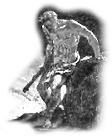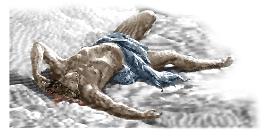|



The following is an excerpt from an article
written by Prof. Dov Noy, M. Grunwald Chair of Folklore at the Hebrew
University.
Prof. Dov Noy dedicates his article as follows: "From the hundreds of
aetiological stories in the Aggadah, I selected the legend of the first
burial, as a way to commemorate my late wife, Dr. Tamar, who passed away
on August 13, 1997, and was buried at the Mountain of Rest in Jerusalem.
As a prehistorian (curator of prehistory at the Israel Museum, Jerusalem)
she studied, among other things, neolithic and ancient burial customs,
with modern ethno-archaeology as her point of departure." May her memory
be for a blessing. |
First times, beginnings and origins of things, have always fascinated
the human imagination. "Myths" are the beginning of science, an attempt
to explain to the curious the beginnings and origins of natural phenomena.
Explanations of first things are often provided even without asking the
questions. Thus, for example, the third chapter of the Book of Genesis
(the fall of man and his expulsion from Paradise) explains the origin
of death, the strange looks of the serpent, the pregnancy of women.
 In
the fourth chapter of the Book of Genesis we have several firsts: the
first sexual intercourse,[1]
the first pregnancy,[2]
the first birth,[3]
and the first murder, fratricide,[4]
which is related to the previous three. The Genesis story devotes less
than a sentence to the actual murder of Abel by Cain (both the first case
of fratricide and the first case of a crime committed by a human being
against his fellow man). Many details are missing: The motivation for
the deed; how the fight proceeded; why Cain won the encounter; whether
weapons were used; whether Abel was aware of his brother's intentions;
how Cain knew the most vulnerable spot in the human body. In
the fourth chapter of the Book of Genesis we have several firsts: the
first sexual intercourse,[1]
the first pregnancy,[2]
the first birth,[3]
and the first murder, fratricide,[4]
which is related to the previous three. The Genesis story devotes less
than a sentence to the actual murder of Abel by Cain (both the first case
of fratricide and the first case of a crime committed by a human being
against his fellow man). Many details are missing: The motivation for
the deed; how the fight proceeded; why Cain won the encounter; whether
weapons were used; whether Abel was aware of his brother's intentions;
how Cain knew the most vulnerable spot in the human body.
 The questions,
while left unanswered in the biblical account, are answered in the post-biblical
midrashim, and are probably based on ancient oral traditions.[5]
Regarding the nature of the dispute between the brothers, for example, four
sages offer different narrative[6]
outlining the reasons for the quarrel: division of property, the site on which
the Temple would be built (Cain or Abel's territory), competition over a woman
(sister, mother). The questions,
while left unanswered in the biblical account, are answered in the post-biblical
midrashim, and are probably based on ancient oral traditions.[5]
Regarding the nature of the dispute between the brothers, for example, four
sages offer different narrative[6]
outlining the reasons for the quarrel: division of property, the site on which
the Temple would be built (Cain or Abel's territory), competition over a woman
(sister, mother).
Another midrash concerns the fate of Abel's body and its disposal. The
Bible does not mention what happened to it. From the admonition and curse
which God directed at Cain[7]
("The voice of thy brother's blood cries unto me from the ground"), we
cannot infer whether the corpse was buried in the earth or left unattended.
The creative folk-imagination in the Aggadic literature expands the Biblical
story in several directions.
We will focus here on that version which has been extant in oral tradition
to this day. In doing so, we will learn how the mythologization in our
oral tradition comes, not only to answer questions left unanswered in
the biblical narrative, but also to legitimize existing customs which
are being questioned or challenged.
According to the oral tradition which prevailed over alternative narratives,
Cain did not expect Abel's death (as never before had an experience of
this kind existed) and, shocked by the silent body, fled from the site
of the crime. Abel's parents, Adam and Eve, looked for their missing son,
and their search ended upon the discovery of his body. Here, too, we are
left with several questions: Why did Abel's body not deteriorate in the
hot, sunny Garden of Eden, and why was it not devoured by the beasts of
the field? What was the reaction of the parents upon confronting the body
of their son? How did they dispose of the body?
Answers to these three questions are supplied in four literary Midrashic
versions:[8]
1. The dog which had guarded Abel's flocks during his lifetime stood guard
over his dead master's body, so that no bird or beasts could harm it.
Another legend tells of birds, flying over Abel's body and shadowing it,
thus preventing its deterioration in the sun.
2. Adam and Eve mourned their son; they sat over the corpse which was
probably on the ground and wept.
3. The mourning parents observed a raven disposing of a dead bird of its
own kind by burying it in the ground. Following the example of the raven.
Adam (Eve is not mentioned) buried Abel's body in the ground. Burial is
introduced here as a male duty and until this very day burial is traditionally
the duty of a son, father and brother.
The three parts of our burial legend not only fill in the narrative gaps,
but also explain the origin of three extant Jewish customs (following
the order of the legend):
1. Why some time should pass between the death of a person and the disposal
of his body;
2. Why, during the period following death and preceding burial, the corpse
should be placed on the floor (not on a bed or table), and the mourners
sit beside it and mourn (weep); and
3. Why the body should be buried in the earth.
It is interesting that Jewish customs which have been mythologized are
generally customs which were attacked and disputed in some Jewish quarters
or by some Jewish sects, as the authority for their practice was not explicitly
stated in the Bible. By expanding the Biblical story, ancient origins
are attributed to a particular custom, giving it sufficient prestige to
withstand the opposition of "fundamentalist" and "scriptural" sects.
Elaborating here on the Jewish custom of laying the dead body on the floor
shortly after death, we may assume that some Jewish sectarians of the
first centuries opposed the Jewish custom as a pagan survival or a Christian
penetration. The Jewish myth, then, not only confirms the pre-pagan and
pre-Christian antiquity of the custom, but also sanctions its use by ascertaining
its divine origin. It is not coincidental that the single narrative which
prevailed in oral tradition regarding the fate of Abel's body was the
one interrelated with existing customs.
|
1. Gen. 4:1
[back]
2. Ibid. [back]
3. Ibid. [back]
4. Ibid., 4:8 [back]
5. Cf. Louis Ginsberg, The Legends of the Jews,
vol. 1, pp. 107 ff, and the respective footnote in vol. 5. [back]
6. Midrash Breishit (Genesis) Raba 22:8 [back]
7. Gen. 4:10-11 [back]
8. The main text is preserved in the narrative Midrash
Pirkei (Chapters of) Rabbi Eliezer, ch. XXI, whence it was probably
taken over by two medieval Midrashic compilations (Yalkut Shimeoni
and Midrash Haggadol). Cf. Dov Noy, "The Story of Abel's Burial: The
Interrelationship of Myth and Custom," in Folklivsgransking,
vol. 21 (Festschrift Olaf Bo), Oslo 1978, pp. 129-140. [back] |
|
Prof.
Dov Noy, M. Grunwald Chair of Folklore at the Hebrew University, has published
and edited over 60 books and collections of annotated folktales, most
of them in Hebrew. Among his English publications are: Folktales of
Israel (Chicago Univ. Press 1963) and Folktales of Morocco
(Herzl Press, NY 1965). Prof. Noy is presently working with Professor
Dan Ben-Amos on The Folktales of the Jews, to be published in 6
volumes by the Jewish Publication Society (which, it is interesting to
note, published Louis Ginsberg's The Legends of the Jews some 90
years ago).
|
|